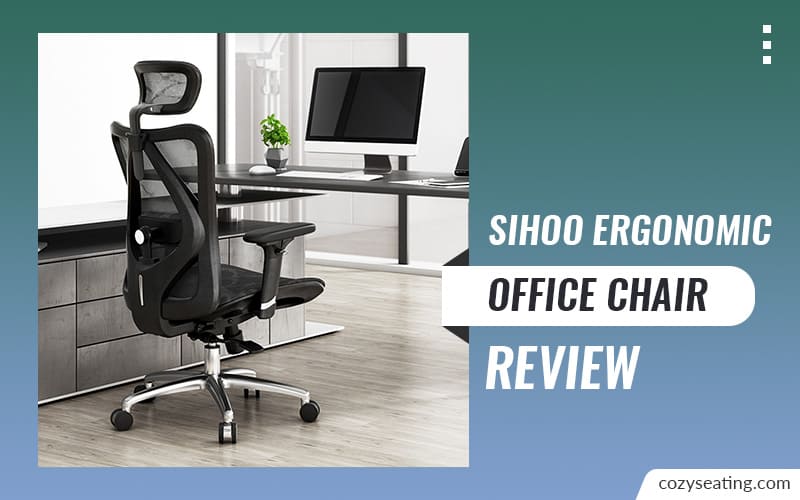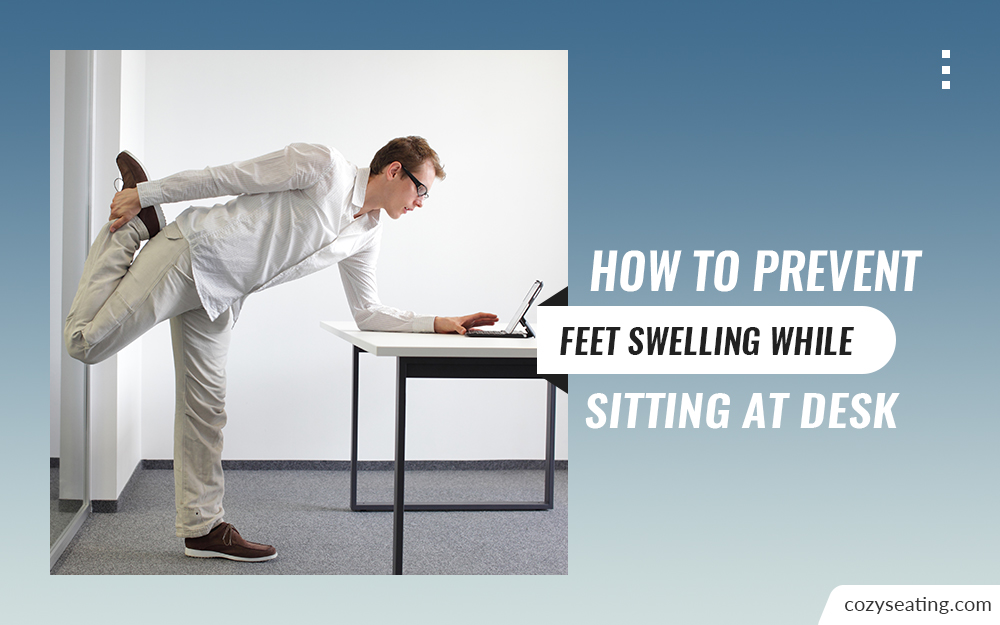
Disclosure: This site is reader-supported & contains affiliate links. We may earn a commission through products purchased using links on this page. Learn more

Do your feet swell while working from your desk chair at work or home? This condition is known as independent edema. Usually, it occurs after long periods of sitting with your legs hanging, where gravity causes excess fluid to settle at the lower part of your feet. Luckily, there are various preventive remedies.
So, how to prevent feet swelling while sitting at desk?
You can prevent your feet from swelling while sitting at the desk by having proper ergonomics and having periodical walk breaks throughout the day. Consider also your diet and lifestyle. Take the proper diet and have some easy-to-perform exercises while sitting to reduce the swelling or keep it at bay.
This article enlightens you on why independent edema occurs, how to prevent it, and more. Let’s get started.
Table of Contents
Why Do Feet Swell From Sitting On A Desk Chair?
Your feet swell from sitting on a desk chair because of excess fluid retention in the feet due to prolonged sitting. The gravity is responsible for this malfunctioning as it draws fluid down your lower extremity, causing poor blood circulation. The retained fluid, in turn, causes soreness and swelling. This condition is uncomfortable, and sometimes, it can be painful.
Sitting on a desk for too long can also be a health hazard to your ankles, knees, hips, and lower back. How? It exerts a lot of pressure on your thighs, minimizing the backflow of blood. As a result, your varicose veins and ankles may swell, while your lower back may experience some pain.
How To Prevent Feet Swelling While Sitting At Desk?
There are various measures you can put in place to prevent swelling while sitting at a desk. You can try lifting your feet above your heart or placing a pillow beneath your legs while sleeping. Make it a habit to move around whenever you break from work to boost your blood flow.
Nonetheless, these may be tricky to apply in some situations, like office setup. Below are some swelling-preventing tips you can apply when you’re out of your workplace. They include:
- Exercising
- Drinking a lot of water
- Health feeding
- Wearing compression socks
- Invest in a standup desk
- Add some desk peddles
Let’s look at each of these remedies in detail.
1. Exercising
Regular exercise keeps your body fit. There are some easy-to-do exercises that help you combat the swelling of your feet while sitting at a desk, including:
- Knee lift
- Leg extension
- Foot pumps
- Ankle Pump
- Ankle circles
Below is an explanation of each of the above exercises.
Knee Lift
Raise your leg towards your chest as you contract your thigh muscles and slowly lower it down to its usual position. Repeat this severally per session for both legs. This type of exercise boosts flexion of knees and hips, resulting in improved blood circulation. As a result, there’s the proper backflow of fluid from your legs, reducing the risk of excess fluid retention.
Leg Extension
Lift your foot and stretch it straight forward. Maintain that position for a few seconds and return to the ground. Do the same with the other leg and repeat the exercise several times. Additionally, you can prop your foot or put it at the edge for extra movement. Try using a stretch strap, a dog leash, or a belt to make the process easier and more productive.
Foot Pumps
This exercise involves lifting toes and heels interchangeably while standing. Have a controlled movement of your toes while you stand on the heels and back to the ground. Switch to raising the heels as you stand on the toes and back. Be sure to do it slowly, remain in the raised position for a few seconds, and avoid bending as yo exercise.
Ankle Pump
Prop your foot by placing a roll on the underside and push down your leg as far as possible. Move the foot upward as far as you can and repeat the same for both feet. This exercise doesn’t engage your mind, and therefore you can repeat it as many times as you’d like.
Ankle Circles
Raise your foot from the ground and move its lower part clockwise several times. Do the same for the other leg and repeat 10 to 15 times per session for both feet.
2. Drinking A Lot Of Water
Contradictorily, drinking plenty of water reduces fluid retention that causes foot swelling. It’s advisable to take eight to ten glasses daily to keep your body hydrated. Failure to drink enough water forces your body to hold back any remaining fluid leading to swelling.
Additionally, sufficient water supply in your body leads to proper blood circulation and the removal of waste fluids through urine and sweat. That minimizes the risk of excess water retention.
3. Health Feeding
Practicing healthy eating culture minimizes the chances of swelling of your feet. Ensure that every meal you take has the correct daily portions of vegetables, fruits, and other heart-friendly foods to enhance proper circulation. Also, avoid excess salt intake and refrain from adding uncooked salt to your food.
4. Wearing Compression Socks
When you wear compression socks, they pressure the legs’ veins, increasing the blood flow. As a result, oxygenated blood to your feet causes the artery veins to relax, allowing a free flow of blood. Consequently, your heart has it easy to bring blood back to it for oxygenation.
The proper circulation alleviates chances of excess water retention and swelling in your feet.
5. Invest In A Stand-Up Desk
This desk allows you to have a comfortable standing posture when working. Also, you can adjust its height to have a sitting position. That way, you can alternate between sitting and standing posture and keeps swelling at bay.
6. Add Some Desk Peddles
When you put your foot peddle under your desk, they allow you to have some light exercises all day long. That improves your circulation and eliminates swelling.
When Should You Seek Help For Your Swollen Legs?
You should seek help for your swollen legs when you’ve tried all the above remedies and the swelling persists. While there are many other causes of foot swelling besides sitting, it’s crucial to identify the root of your problem by contacting your doctor.
Why?
You may be having an underlying problem that needs medical attention. If not, your provider may prescribe some water pills known as Diuretics which increase water and salt levels in your body.
You should call 911 or your local emergency center if your foot swelling is accompanied by:
- A chest pain that feels like tightness or pressure
- Shortness of breath
Also, it’s advisable to call your doctor immediately you notice foot swelling if:
- You’re pregnant, and your swelling is beyond a mild case or has suddenly become severe.
- You develop some fever
- Your swollen leg becomes warm or turns red.
- You notice swelling, and you’ve got a history of liver disease.
- Your swelling worsens, and you’ve heart or kidney disease.
What Shouldn’t You Do About Swollen Feet?
You shouldn’t make the following mistakes about swollen feet. Instead, do your best to prevent swelling from occurring, and if it develops, don’t turn a blind eye to it.
To keep your feet off swelling, don’t practice the following sitting positions:
- Crossed legs: While it may feel relaxing and comfortable, it can be harmful in the long run. This posture exerts pressure on one foot while the other relaxes and hangs. The grounded foot feels the negative effect of your weight and fluid downward, causing tension and stress.
- Sitting on your feet: You want to relieve tension on your leg and back by propping up yourself while sitting on your feet. While it may feel relaxing, all your body weight rests on your feet, causing distress due to the unusual conditions. If you’ve been doing this regularly, take a break to relieve your knee, ankle, and feet from the discomfort.
- Outstretched and crossed legs posture: This position looks reclining and comfortable. Nonetheless, it stresses your ankle and legs’ heels. Even worse, it puts a lot of pressure and poor curvature on your spine.
In a nutshell, feel-good sitting positions can be health hazardous. Hence, it’s essential to understand proper sitting ergonomics.
What Are The Other Causes Of Foot Swelling?
There are several other causes of foot swelling apart from prolonged sitting, including:
- Standing for long: It denies your feet muscles a chance to contract, slowing down blood flow in and out of your legs.
- Consuming too much salt: The sodium in the salt is a significant catalyst for fluid retention in your body. Most of it is found in preservatives used in restaurants and processed foods.
- During pregnancy: Swelling occurs in the second trimester due to the increased baby’s weight that presses the pelvis veins, compromising your circulation.
- Overweight: The high-fat levels in your belly and back pressure downstream hinder proper circulation leading to swelling.
- Injured foot or ankle: Your body’s response to a severe fracture is swelling. Fluid and cells move to the affected area to heal, causing inflammation.
- Hormone fluctuations: Premenstrual syndrome, hormone replacement therapy, or hormonal contraception can cause swelling of your feet.
- Medication: Some drugs, such as those used to control high blood pressure, diabetes, and heart disease, prevent sodium excretion from your body, causing water retention.
- Infections: Bacterial infections cause foot swelling associated with redness, hotness, and soreness. Broken skin can give way to bacteria.
- Lymphedema: A damaged lymphatic system causes swelling. Lymphatic fluid transport infection-fighting white blood cell throughout the body. Hence, the lymphatic fluid flow slows down if the pelvis lymph nodes are removed or damaged.
- Heart malfunctioning: When your heart can’t pump enough blood, it remains in the veins, causing fluid build-up.
- Blood clot: It increases pressure on the blocked area, pushing fluid out of the vein into the tissues causing inflation.
- Kidney failure: Your kidneys ensure fluid balancing in the body and get rid of any unwanted fluid. Water retention is highly likely when one or both kidneys develop a problem.
- Liver disorders: Your liver may develop some scars, perhaps due to excessive drinking of alcohol or hepatitis. That hinders the proper flow of blood in and out of the liver. Consequently, high blood pressure develops in the responsible veins causing swelling of your feet.
Related Articles:
Is Sitting In A Recliner Harmful To Your Legs?
How To Sit In Office Chair During Pregnancy
10 Best Office Chair for Lower Back And Hip Pain
FAQ
Is Edema In The Legs Life-Threatening?
No, edema in the legs isn’t life-threatening. It’s a common issue that can result from various medical conditions. Fortunately, this problem can be treated where the treatment is personalized and depends on the root cause. Nonetheless, it can be an indication of a dangerous condition that needs immediate attention.
What Happens If Edema Is Left Untreated?
If edema is left untreated, it can become an excruciating swelling, causing stiffness and walking difficulties. Moreover, your skin becomes itchy or stretched or develops skin ulcers. Untreated edema may also result in low blood circulation, leading to a decline in your overall health.
Do Compression Socks Actually Work?
Yes, compression socks actually work. There’s sufficient evidence that compression socks are excellent in reversing vein-related diseases of the legs. Compression socks improve the blood circulation of your legs and prevent its pooling in the legs’ veins. Consequently, they prevent swelling of your feet.
Can High Blood Pressure Cause Swelling In The Feet?
Yes, high blood pressure can cause swelling in the feet. However, that only happens if left uncontrolled. Unmanaged hypertension can cause a heart disease whose major symptoms may be feet swelling.
Why Do Feet And Ankles Swell In Elderly People?
Feet and ankles swell in elderly people due to fluid accumulation in the surrounding muscles’ soft tissues. The inflammation can result from extended periods of sitting or standing, a high intake of salt in their diets, taking specific prescriptions, or having an ankle injury. This condition is common to many seniors.
Bottomline
If you’ve identified sitting for long hours as the sole source of your feet swelling, there’s no cause for alarm. There are many causes of this inflammation, and the sitting posture-related one is the easiest to prevent or treat.
This write-up provides the various measures you can take and say goodbye to foot swelling. Regular exercise, drinking enough water, and a balanced diet are simple and affordable remedies. You could also consider investing in a standup desk, adding peddles to your desk, or buying compression socks.
Having this sufficient information, you’ve no reason to continue experiencing pain that makes your work-life uncomfortable. Try all and run with your most effective one!
Recommended Reading

7 Best Sihoo Ergonomic Office Chair Review (2022 – Updated)
Sihoo ergonomic office chair review brings you honest opinions on top Sihoo office chairs. Check the several options and choose a suitable one.
![How to Make Office Chair Higher [9 Easy Ways]](https://cozyseating.com/wp-content/uploads/2021/09/How-to-Make-Office-Chair-Higher.jpg)
How to Make Office Chair Higher [9 Easy Ways]
This article will show you how to make your office chair higher. This is a great way of making your chair more comfortable and also of good ergonomic value.

12 Best Victorian Office Chair To Buy in 2022
Are you looking to go vintage this year? This review helps you to discover the best Victorian office chair.

What is the Knob Under My Office Chair for?
What is the knob under my office chair for? Use it to adjust the back or seat height, tilt tension, or seat angle. Click the link to know more uses.
